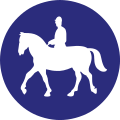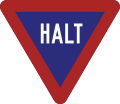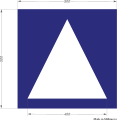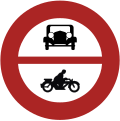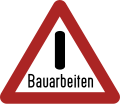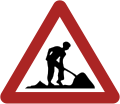Illustration of the traffic signs in the Federal Republic of Germany from 1953 to 1956
The picture table of the traffic signs in the Federal Republic of Germany from 1953 to 1956 shows the traffic signs in the Federal Republic of Germany as they were decided by the Road Traffic Act (StVO) in the version of August 24, 1953. This StVO came into force on September 1, 1953. In addition to the traffic signs of the StVO, the traffic-related sign arrangements in the traffic gazette and in the railway building and operating regulations (BO) are discussed here. On the basis of the first general administrative regulation for the order management of federal highways of July 3, 1951, the motorway traffic signs are also dealt with here.
The StVO of 1953 did not replace the road traffic regulations that had been in effect since 1938, but was an amendment for the young Federal Republic. As early as December 1, 1951, far-reaching changes to the text of the Road Traffic Licensing Regulations (StVZO) had been made. With the amendment of 1953, on the one hand, many requirements of the pre-war regulations were confirmed, and on the other, new developments and findings in road traffic were addressed. In addition, the 1937 StVO was adapted to the conditions in the Federal Republic. It was planned that the old traffic signs would have to be replaced during a transition period until March 31, 1955. After the traffic volume increased drastically due to the rapid economic upswing immediately after the establishment of the Federal Republic and new, increased demands on traffic safety became necessary, a further, comprehensive revision of the StVO was necessary as early as 1956.
62nd. Military Police Highway Patrol Company
At the end of 1948, a Military Police Highway Patrol was established in the US occupation zone , which existed until 1958. The units, equipped with American patrol cars, were in use on the entire highway network of the US zone. The tasks of these police officers included ensuring road safety, observing traffic rules and helping with law enforcement in rural areas. In addition, the Highway Patrol was well versed in traffic assistance and helped with traffic accidents. A German police officer often accompanied the operations, among other things to act as an interpreter and to implement German law.
Colours
As already confirmed in 1949, the traffic signs were again based on the RAL color register 840 R containing the official colors . This color register was first introduced in 1940, at the beginning of the war, and replaced the sample card that had been valid since June 1932. The first post-war edition of this register was published in 1953.
The colors specified in the 840 R color register for the traffic signs were:
- RAL 3000 (red)
- RAL 1007 (yellow)
- RAL 5002 (blue)
- RAL 9005 (black)
- RAL 9001 (white)
The current names of the RAL colors did not exist at that time.
typography
The typographical basis formed the standard sheet DIN 1451 in its edition of February 1951. As a recommendation it was determined that the fonts contained there should adhere to a minimum line width of 7 millimeters. Large letters should not be displayed under 50 millimeters high and small letters not under 35 millimeters high. Exceptions to these regulations have been set out on separate sample sheets.
Since typographic characters in particular were often still created by sign painters at that time, there could be significant deviations in the typeface and the expression of individual letters.
Manufacturing
For the manufacturer, the requirement was that the signs were made light-proof and weatherproof. The sign “Stop! Pay attention to the right of way! ”(Fig. 30a) also had to be illuminated either from inside or outside or to have a reflective effect. This regulation related to the red border and the white lettering "Halt". It was considered permissible to equip all other signs with retro-reflective design, whereby the manufacturers should concentrate in particular on the warning signs (Figures 1 to 10). At that time, the industry had already developed paints for reflective finishes. Traffic signs that were illuminated by car headlights showed a retroreflective effect.
I. Warning signs
(Pictures 1 to 10)
Marks for level crossings at rail height
(Pictures 4c to 10)
In December 1955 it was determined for the state of Lower Saxony that from January 1, 1959 picture 4e can be set up instead of 4d and picture 4g can take the place of picture 4f.
II. Mandatory and prohibitive signs
(Pictures 11 to 31b)
Time restrictions of the commandments or prohibitions were indicated by white inscriptions on the red border of the boards.
III. Notice signs
(Pictures 32 to 51)
Time limits for picture 32 were indicated by white inscriptions on the sign. In picture 33, the reason for the reminder, for example "school", can be specified under the triangle. In this case the triangle slipped to the upper edge of the board, which did not increase in its entirety. Figure 34 could also contain a white arrow to indicate the direction of the aid post or to provide more detailed information in white letters. In addition to the symbol of the Red Cross, the symbol of another officially recognized organization could also be represented.
Signs for lanterns that don't burn all night
(Pictures 35 to 36)
More white lines and arrows on the road
Place-name sign
(Pictures 37 to 38)
Instead of the administrative district, since the introduction of the StVO, which came into effect on January 1, 1938, the term “ customs border district ” could be used in the border areas . There was no separate picture for this in the regulation.
37
Place name sign (front)
Signpost for federal highways
(Pictures 39 to 41)
As a rule, the signposts should only contain locations that were included in the official map series "Overview map of Central Europe 1: 300,000."
Signpost for other paved roads
(Picture 42)
As a rule, the signposts should only contain locations that were included in the official map series "Overview map of Central Europe 1: 300,000."
Signpost for unpaved roads
(Picture 43)
These signs were intended for places unsuitable for motor vehicles. Here only the name of the next place had to be given.
Federal trunk road license plate
Figure 45 from the 1937 Road Traffic Act was omitted without replacement.
Pre-signpost
(Pictures 46 to 51)
Signs for priority roads
IV. Sign for directing traffic in the event of road closures
(Pictures 53 to 58)
Signal discs on bogies for traffic control in case of half-sided closures
(Pictures 53 to 54)
Signpost for diversions
(Pictures 55 to 56)
Sign for diversion of traffic on federal trunk roads
(Pictures 57 to 58)
Corresponding boards were also used on the motorways.
Unnumbered characters that have been valid since January 1, 1938
With the amendment to the Road Traffic Act of 1953, the following symbols were confirmed, which could be ordered without numbering.
Additional boards
Warning signs for construction sites
These signs, which were ubiquitous at the time, were not among the official traffic signs of the StVO.
Imagery introduced by 1956
Not listed in the StVO, but signs published in the Reichsverkehrsblatt
The following stop signs were originally prescribed in the German Reichsanzeiger and Prussian State Gazette No. 172 of July 28, 1939 and published in the Reichsverkehrsblatt 1939, but they were not included in the road traffic regulations, although they were considered traffic signs in the sense of the StVO. With the ordinance amending the tram construction and operating regulations of August 14, 1953, the validity of the stop signs published in 1939 was confirmed. The 1939 ordinance was not repealed until 2006.
Example of a stop sign for motor vehicle lines of the Kraftpost
Control facilities
The provisions of the provisional guidelines for the expansion of rural roads (RAL 1937) from December 1942 continued to apply in the Federal Republic in part. It said in Elsner's pocket yearbook for road construction 1954 : "For the shape and dimensions of the guide stones and milestones, the provisional guidelines for the expansion of rural roads (RAL) apply." However, there were textual modifications, such as the textbook Die Straße from 1951 and that Confirm paperback for civil engineers from 1955. At road junctions and crossings, white tree mirrors (0.70 meters high, 0.30 meters wide, 0.50 meters above the road surface) had to be attached to the tree trunks for each direction of travel. If there were no trees, guiding stones made of granite, limestone or diorite were to be set up. If the natural stone turned out to be too dark, it had to be painted light. Concrete blocks should only be used if the freight costs for natural stones were too high. In addition, the stones were only to be painted on the outside of curves as well as at road junctions and crossings, with guide pegs being placed on dams in addition to guide stones. The paint for the guiding stones consisted of a 0.20 meter high white head and a 0.12 meter high black line immediately below it. Overall, guide stones or delineators should be placed wherever no other clearly identifiable features were to be found. As the specific information in the handbook for civil engineers also shows, the dimensions of the guiding stones remained identical to the original guideline. The four-foot-long wooden guide pegs had a diameter of six inches and a white head that was eight inches high and a twelve-inch-wide black ring underneath. They should protrude 0.70 meters above the ground level. The street numbering now was not located more to the Leitsteinen but on specially carved or cast concrete kilometer markers , with the side facing the traffic wider side, the painted black numbering had the mileage and the narrow side of the street on a yellow background. A milestone could replace a guiding stone if necessary. There were protective systems and dividing lines as additional control systems.
Marking of the level crossings at rail height
Gated level crossing
Transitions with warning lights
These signs were not included in the road traffic regulations. Their arrangement and set-up were regulated by the Railway Building and Operating Regulations (BO).
A slowly flashing white light (45 flashes per minute) meant: The crossing is free for road traffic . A rapidly flashing red light (90 flashes per minute) meant: Stop! The crossing is closed to road traffic . Several models of warning lights were used to secure the unrestricted level crossings. The technically most demanding version was intended for multi-track, unbarred level crossings. When two trains approached the crossing from both directions, next to the obligatory red warning light, the words "Two trains" came on and an alarm clock went off. Paragraphs 79 (1) and 82 of the Railway Building and Operating Regulations govern the use of the signal system. Both the arms of the warning cross and the white-red border of the carrier plate were provided with round reflectors to make the signs even more recognizable for drivers in the dark.
Still valid warning lights from the pre-war period
While the previous, very reliable warning light systems in Germany showed a white, slowly flashing optics when the crossing was free and a red, rapidly flashing light when a train was approaching, the Deutsche Bundesbahn experimented with experimentally put into operation at the beginning of the 1950s Systems that only had a red flashing light. The basis for this development was the efforts of the Union International des Chemin de Fer (UIC) from 1950 to standardize this type of security system across states. With the approval of the Federal Ministry of Transport, a large number of the new flashing light systems were installed as early as 1953.
Warning and flashing light systems of the Deutsche Bundesbahn
Motorway signage
The signage for motorways was not included in the amendment and was adopted as federal law from the "Decree on traffic signs and facilities on Reichsautobahnen of April 15, 1938". This was confirmed by Section 3 of the “First General Administrative Regulation for the Administration of Contracts on Federal Highways (1st AVVFStr.) Of July 3, 1951”. The pre-war coloring was also retained. The color RAL 5002 corresponded to RAL 32h, which was used in the 1930s. As a rule, the large motorway signs were made of wood and plywood and thus had a significantly shorter lifespan than the metal signs used later. The panels had a white border that could either be painted on or designed as a wooden frame.
Boards in the median
Boards on the right edge of the road
literature
- The Federal Minister of Transport: Instructions for the arrangement and execution of lane markings on federal trunk roads (HMB) . Verkehrs- und Wirtschafts-Verlag, 1954
Web links
Remarks
- ↑ Bundesgesetzblatt , year 1953, No. 56, date of issue: Bonn, September 3, 1953, p. 1166.
- ↑ Bundesgesetzblatt , year 1951, No. 54, date of issue: Bonn, November 28, 1951, p. 918.
- ↑ Replacement of new traffic signs by March 31, 1955 . In: Verkehrsblatt , 1953, No. 289, p. 331.
- ^ Reminder page of the 62nd Highway Patrol (MP) - Germany ( Memento from May 22, 2016 in the Internet Archive ).
- ^ Gregor Maria Kirschbaum (Ed.): The road law. Continuation work in loose-leaf form. A complete collection of all important legal provisions from road traffic and road construction, with additions and explanations according to the latest legal developments. Kirschbaum, Bielefeld 1949, p. 30.
- ↑ a b c d Federal Law Gazette, year 1953, No. 56, date of issue: Bonn, September 3, 1953, p. 1217.
- ↑ Johannes Denecke: Lackfarben 1932-1945. In: Johannes Denecke Camouflage paints of the German army 1914 to today , Bernard & Graefe, Bonn 1999, ISBN 3-7637-5990-5 . Pp. 104-106.
- ↑ Design and execution of traffic signs . In: Straße und Autobahn , Issue 4, 1980, p. 287.
- ↑ Otto Merz: Painting in the sheet metal processing industry . In: Surface treatment in sheet metal processing 2, Düsseldorf 1951, p. 57.
- ↑ Ordinance on the construction and operation of connecting railways of December 14, 1955. Appendix C to Section 13 Paragraph 2. In: Niedersächsisches Gesetz- und Verordnungsblatt Sb. I, pp. 756 ff.
- ↑ a b Federal Law Gazette, year 1953, No. 56, date of issue: Bonn, September 3, 1953, p. 1214.
- ^ Federal Law Gazette, year 1953, No. 56, date of issue: Bonn, September 3, 1953, p. 1228.
- ↑ Bundesgesetzblatt , year 1953, No. 56, date of issue: Bonn, September 3, 1953, p. 1215.
- ^ Ordinance on behavior in road traffic (Road Traffic Regulations - StVO -) of November 13, 1937 . In: Reichsgesetzblatt , part 1, year 1937, no. 56, Berlin, November 16, 1937, p. 1193; Ordinance amending the Road Traffic Licensing Regulations and the Road Traffic Regulations of August 24, 1953. In: Federal Law Gazette, Part 1, No. 56, Bonn, September 3, 1953, p. 1216.
- ↑ a b c Federal Law Gazette, year 1953, No. 56, date of issue: Bonn, September 3, 1953, p. 1216.
- ↑ a b Reichsgesetzblatt , year 1937, no. 56, date of issue: Berlin, November 16, 1937, p. 1192.
- ^ Reichsverkehrsblatt B, No. 33 of July 29, 1939
- ↑ Ordinance amending the tram construction and operating regulations. From August 14, 1953. In: Bundesgesetzblatt , Part I, No. 51 of August 21, 1953, pp. 974-977; here: p. 974.
- ^ First law on the adjustment of federal law in the area of responsibility of the Federal Ministry for Transport, Building and Urban Development. From September 19, 2006. Article 27: Repeal of the regulation on the introduction of uniform stop signs for trams and motor vehicle lines. In: Bundesgesetzblatt I, No. 44, Bonn on September 30, 2006, pp. 2146–2153; here: p. 2148 and p. 2153.
- ^ Elsner's pocket yearbook for road construction 1954 . Elsner 1954, p. 209.
- ^ A b c Paul Trapp: What the road attendant needs to know about guidance systems! In: ÖTV press. Central organ of the trade union for public services, transport and traffic 5, 1954, p. 78 ff .; here: p. 78.
- ↑ Ferdinand Schleicher (Ed.): Taschenbuch für Bauingenieure , Springer, Berlin / Göttingen / Heidelberg 1955, p. 503.
- ^ Rudolf Kraus: The street. Guide for teaching in higher technical schools . Braun, Karlsruhe 1951, p. 52.
- ↑ Ferdinand Schleicher (Ed.): Taschenbuch für Bauingenieure , Springer, Berlin / Göttingen / Heidelberg 1955, p. 503.
- ^ Paul Trapp: What the road attendant needs to know about guidance systems! In: ÖTV press. Central organ of the trade union for public services, transport and traffic 5, 1954, p. 78 ff .; here: p. 111.
- ↑ E. Besser: Lighting technology in railway operations . In: Rudolf Fewig (Ed.): Handbuch der Lichttechnik , Part 1, Springer, Berlin 1938, pp. 881–894; here: p. 893.
- ↑ Heinrich Korner: New warning lights for unrestricted level crossings . In: Elektrotechnische Zeitschrift Edition B (Der Elektrotechniker), 2, (1953), p. 54.
- ^ Richard Meyer: Structure and changes in railway law . In: Public Administration. Journal of Administrative Law and Administrative Policy, 1950, pp. 420–424; here: p. 424; Heinrich Korner: New warning light systems for unrestricted level crossings . In: Electrotechnical Journal . Edition B (Der Elektrotechniker), 2, (1953), p. 54.
- ↑ Germany in reconstruction. Federal government activity report for 1953 . Bonn 1954, p. 216.
- ↑ Federal Gazette No. 132; Beck's text editions, Road Traffic Regulations, 10th edition, CH Beck, Munich, 2008, introduction, p. 17, footnote 4
- ↑ Johannes Denecke: Lackfarben 1932-1945. In: Johannes Denecke Camouflage paints of the German army 1914 to today , Bernard & Graefe, Bonn 1999, ISBN 3-7637-5990-5 . Pp. 104-106; here: p. 104.




























